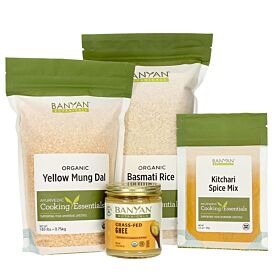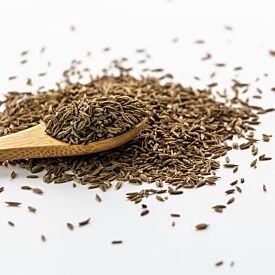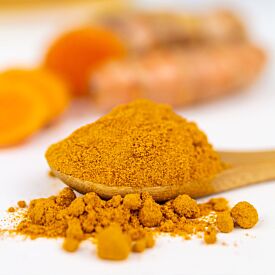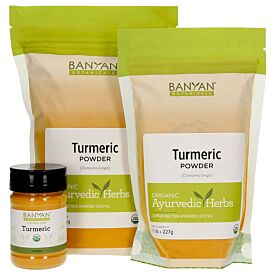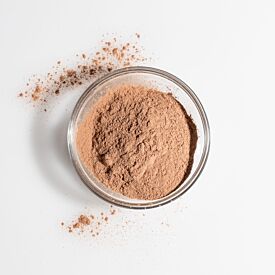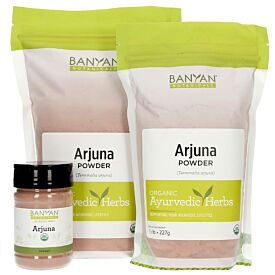Celebrating Menopause Guide
In a culture that tends to glorify youth and productivity, thinking about menopause and the changes that come with it can bring up trepidation. Navigating this time of life can be challenging to say the least, but it can also be a window of opportunity and a new beginning—a chance to realign with our values and prioritize our own well-being.
We may have heard stories from friends about their own trials through menopause—and for those of us who have yet to go through it, we might end up feeling resigned to a similar experience.
For many of us, it conjures visions of hot flashes, dizzying mood swings, and long nights lying awake.
Thankfully, the Ayurvedic approach can help ease many of these challenges and support a different experience—one that is graceful, luminous, and empowered
In this article:
- Menopause in Ayurveda
- An Ayurvedic Perspective on Menopause and Hormones
- How the Doshas Influence Menopause
- The Path to a Graceful Menopause
- Tips for 5 Main Concerns of Menopause
- Embracing Menopause Early
Menopause in Ayurveda
The classical Ayurvedic texts do not refer to menopause as a disorder. In fact, menopause, as a disease, has been known to be relatively uncommon in the East until recently, particularly in non-urbanized areas that have been less affected by westernization. For this reason, many refer to it as a disease of the West.1
From an Ayurvedic perspective, the stage of life you’re going through at a given moment can impact your overall health—especially when it comes to menopause and its associated experiences.
Ayurveda recognizes three major stages of life—childhood, adulthood, and elderhood. Each stage is associated with one of the three doshas.
- Childhood (Brahmacharya Ashram) is generally viewed as a time full of growth, building, and learning. Ayurveda associates this stage of life with kapha, the dosha of earth and water.
- Adulthood (Grihastha Ashram) is considered the time of achievements and accomplishments, and is associated with pitta, the dosha of fire and water.
- Elderhood (Sannyasa Ashram), traditionally, has been viewed as a period of letting go of the need to achieve. It is associated with vata, the dosha of air and ether.
When you enter menopause, you’re transitioning into the vata-dominated period of your life, which allows for insight, clairvoyance, and wisdom to grow from deep reflection and contemplation on the life lived thus far. Vata also has a dispersing nature, which may inspire some to share this wisdom with their loved ones and society at large.2
Some reach this stage of life with a sigh of relief—knowing that all of our major responsibilities have been taken care of, and fully ready to shift awareness within. This stage of life is a terrific opportunity to get to know ourselves and make time for self-care, reflection, and meditation.
That said, not all of us are retired (or even close to retirement) when we reach menopause, which can make the experience a more daunting prospect.
So how do we balance menopause with our daily lives? Can Ayurveda’s ancient wisdom still apply to modern day living? The answer is yes! Read on to learn how.
An Ayurvedic Perspective on Menopause and Hormones
During menopause, levels of estrogen and progesterone, two powerful female hormones, drop. Both of these hormones provide two subtle, yet vital substances in our body:
- Ojas. Ojas is a superfine substance that is responsible for building immunity, stability, and nourishment. As such, it can be seen as a very subtle and refined form of kapha. The very end product of nutrition in our body, after it passes through all of the seven layers of tissues (or dhatus), including the final layer of our reproductive organs, is ojas.
Our immune system, which thrives when we have strong ojas, gives us the ability to tolerate our external environment, as well as changes to our internal ecosystem. So it happens that those with low ojas are more prone to imbalances and illnesses.
For instance, you will see that with hot flashes, a lack of hormones causes the temperature zone in which we feel comfortable to narrow substantially. This makes it difficult to remain within a comfortable temperature range. - Tejas. Tejas is a refined version of pitta. It acts as the positive subtle essence of agni, our digestive fire. It governs intelligence, discernment, enthusiasm, and all types of digestion and transformation.
Without tejas, there is no guidance as to where pitta and heat should flow to so it can serve its purpose. Ideally, the mind and body by this point in the life cycle have built enough intelligence to continue with these functions without necessarily needing hormones to guide it. But if tejas is lacking, we can experience imbalance.
Since hormones serve vital pitta and kapha functions, it is very important that these two doshas, specifically, are balanced to a very healthy level when entering menopause.
- Pitta should primarily reside in its home in the core, providing a solid source of agni. Kapha should not be depleted, as it nourishes all tissues so that they are not whisked away with the littlest change.
During menopause, we are low on ojas, and so we have a lessened ability to maintain balance, even in the same environment and with the same stressors. Couple that with the erratic nature of vata, and when unchecked, our body shifts into a sympathetic overdrive.
Our nervous system is a delicate balance of the sympathetic nervous system, a stress-oriented system that exists for self-preservation, and the parasympathetic nervous system, which functions to relax and renew. These two branches work as opposing yet complementary systems.
Because of low ojas, menopause becomes a state of high sympathetic nervous system—cortisol levels increase, blood pressure increases, heart rate increases.3 This state of stress drives high pitta throughout the body, ready to attack any threat.
Further this with the cessation of the monthly blood release. The menstrual cycle can be seen as a therapeutic rakta moksha. This is a therapy used in traditional panchakarma, where blood is let out for the purpose of releasing excess pitta.
In the ideal, healthy state of the menopausal individual, we shift away from pitta predominance, mentally and physically, to vata predominance. In an ideal scenario of perfect health, the body would transition just fine. But with persistent pitta activities and constant activation of the hot and sharp sympathetic system, pitta remains trapped in the body. In the end, we are left with the following process:
- Elevated, ungrounded vata disperses throughout the body, carrying your core digestive fire, agni, away from its home in the stomach and intestines. This leads to difficulty with digestion and overall nutrition.
- The heat traveling in the circulatory system gives rise to hot flashes, troubled sleep, and, in an extreme case, heart disease.
- High vata also flows downward, drying out the vagina.
- High vata in the colon and other deeper tissues causes dryness. In an extreme case, it can lead to conditions such as osteoporosis.
- Superfine tejas, also decreased, leads to troubles with memory and concentration and a higher predisposition to cancers.
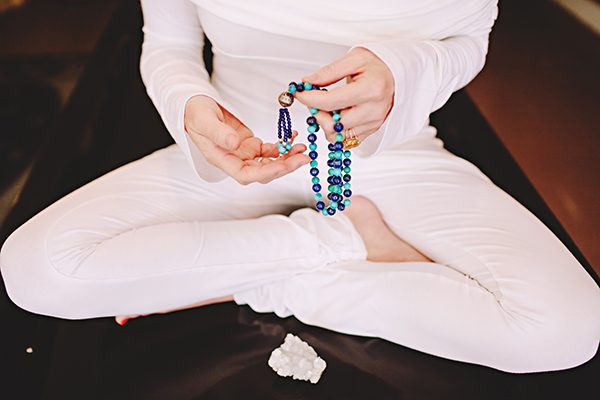
How the Doshas Influence Menopause
As with all of Ayurveda, there are many ways that an imbalance can manifest. The interplay of the doshas add different layers of diversity. Use this table to understand what flavor your menopausal transition has or will have. Knowing this will help you see what doshas may be out of balance so that you can adjust your diet and lifestyle accordingly. Take the dosha quiz to determine which dosha or doshas you should focus on balancing.
|
Vata |
|
|
Pitta |
|
|
Kapha |
|
All of these shifts—the changes in hormones, the reduction of ojas and tejas, and the influence of the doshas—often cause an imbalance in the gunas, or qualities, leading to too much dry, rough, mobile, subtle, spreading, cold, or hot qualities. We can see these reflected in the above table—increased dryness can lead to dry skin, while increased heat can lead to hot flashes and irritability.

The Path to a Graceful Menopause
While most studies are small or preliminary, there is a growing body of evidence and exciting initial findings to support an alternative approach to menopause that embodies nourishment, contentment, and balance.
There is also growing support for herbalists and alternative practitioners and their care for reproductive health.4 A holistic approach not only eases many of the challenges that many who go through menopause face, but also empowers us to live with more joy and fulfillment.
Ultimately, attaining the luminous, graceful menopause that the sages have lived from time immemorial can be simplified into three main goals:
- Increase juiciness. Some kapha during menopause is a great thing, as long as it is in balance.
- Be calm. Bring vata and pitta back to balance by calming the sympathetic nervous system.
- Strengthen your agni. When your agni functions optimally, your whole body functions optimally because it is well nourished and has the intelligence it needs.
Keep these goals in mind as you make your way through the basic pointers outlined below. Remember the aggravating qualities of menopause—dry, rough, mobile, subtle, spreading, cold or hot—and see the opposing qualities come to life in the recommendations.
Make Peace with the Past. Making peace with the past and creating acceptance for the present and future is the single-most important element of your transition. There is nothing that drives our stress like anger, resentment, and irritations—especially from the past.
Take time and make space to make peace with yourself, all those that you have crossed paths with, and your life at large.
Do a Monthly Cleanse. Take two tablespoons of ghee with two tablets of Blood Cleanse twice daily for four days each month as you go through the transition, especially if you are experiencing lots of heat and high pitta.
Eating an easy-to-digest kitchari diet and doing a daily abhyanga during these four days will support the cleansing process.
Eat a Vata-Balancing Diet. A vata-balancing diet (that does not aggravate pitta) consists of warm, well-cooked foods, cooked with spices that aid in digestion, such as cumin, fennel, coriander, saffron, turmeric, and hingvastak.
Support Your Agni. Have a teaspoon of grated ginger with lime and a pinch of salt before and after meals. You can also drink CCF Tea (cumin, coriander, and fennel seeds) throughout the day.
Practice Pranayama and Yoga. Learn the art of breathing slowly and deeply and use yoga to calm your nervous system, decrease stress, and help with menopausal symptoms.5,6 If you’re new to pranayama, start by practicing Nadi Shodhana (Alternate Nostril Breathing) daily for up to 20 minutes.
Try Yoga Nidra. Also known as yogic sleep, yoga nidra is a meditative process done while lying on your back or in a similar comfortable position. Take at least 10 minutes every afternoon to practice this restful process to ease your mind and calm your nervous system.7,8
Bathe Yourself in Moonlight. Spend summer nights moon bathing. The direct illumination from the moon was traditionally used as a therapy to increase ojas and bring coolness to the body. Even just 15 minutes a few times a week can make a difference.
Take Women’s Natural Transition. Women’s Natural Transition formula has the perfect blend of herbs that nourish and calm vata, while at the same time cooling pitta.
Increase Moisture. Rasayana literally means “increasing juice.” Dryness is the quality that tends to become most excessive in the menopausal body.
Ways to Increase Moisture
- Abhyanga. Not only does the practice of self-massage literally oleate the body, but it also is one of the most effective ways of calming vata and also the nervous system. Study after study has shown massage as effective in easing anxious feelings and stress.9,10,11It can also be very effective at helping with uncomfortable joints.12
- Shirodhara. Shirodhara, the slow pouring of oils on the third eye, is a classic therapy for calming and balancing the mind.13 Find an Ayurvedic therapist that can support you with this therapy.
- Hydration. Your body is 75 percent water and requires this fluid for nutrition and elimination of wastes. Drink plenty of water and have sufficient electrolytes and essential fatty acids to help maintain the quality and quantity of your waters.
- Chyavanprash. Chyavanprash is one of the most classic rejuvenating formulas used in Ayurveda. It was created to build nutrition and ojas. It also has natural antioxidant properties, as amalaki is its primary ingredient.14
Tips for 5 Main Concerns of Menopause
While all of the recommendations discussed are amazingly beneficial for overall menopausal wellness, there are particular areas where you might want more specific guidance. In the following section, we will review the top five most common concerns associated with menopause.
1. Cooling Hot Flashes
Up to 80 percent of those going through menopause suffer from hot flashes. This is important, not only as a cause of unease, but also as a sign of significant pitta running havoc throughout the bloodstream. Regular hot flashes can be a sign of further imbalance in the body.15
Like most other menopausal symptoms, it is a signal to take rest and relax—your sympathetic nervous system is on high.16
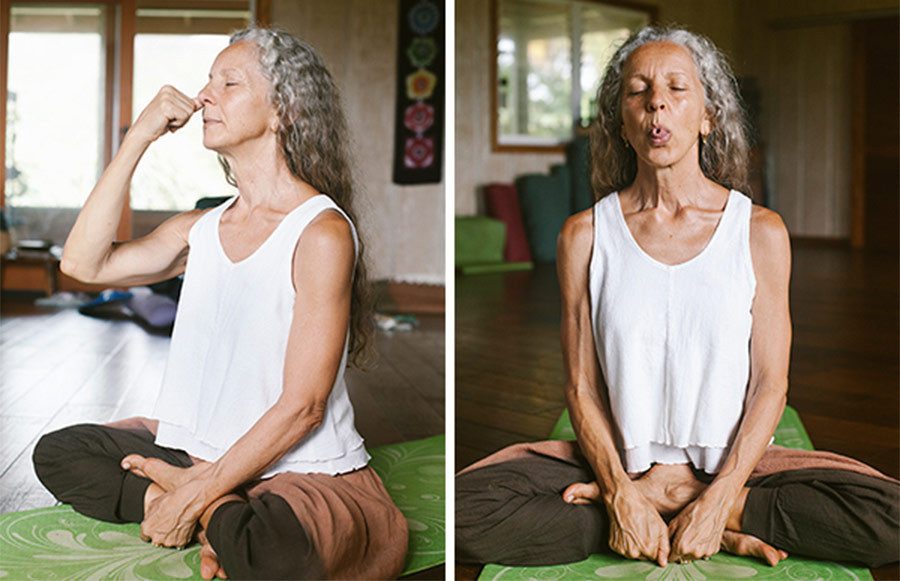
Practice a Cooling Pranayama. Try practicing Nadi Shodhana for up to twenty minutes daily to decrease your level of stress and calm your nervous system. Sheetali Pranayama (Cooling Breath) is extremely cooling and can be used during a hot flash.17
Adjust Your Diet. Reduce caffeine and alcohol intake and eat pitta-balancing foods which are also energetically cooling, such as coconut oil.18
Drink Pomegranate Juice and Fresh Lime or Peppermint Tea. These refreshing drinks can cool and cleanse the blood of natural toxins and excess heat.
Maintain a Healthy Weight. Excess weight can serve as an insulating layer, making the body hotter.19,20 But be careful—if you are underweight, losing further weight will create stress on the body.
Meditate. The ability to maintain inner peace despite external circumstances can serve all of us well. A daily dose of meditation and other ways of achieving mindfulness can go a long way with hot flashes.21
Herbs for Cooling the Body
- Healthy Pitta helps balance pitta in the body with cooling herbs.
- Blood Cleanse will help remove excess pitta from the blood specifically.
2. Improving Sleep
To bring more restful sleep, increase heaviness—especially before nighttime. As most cases of sleep disturbance are caused by hot flashes, the above recommendations will also help.
Drink Milk Before Bedtime. Drink hot, boiled milk with some nutmeg. If you are still having difficulty with sleep, drink milk that has been boiled with two cloves of garlic. With either of these recipes, adding a pinch of turmeric will make the milk easier to digest.
Meditate Before Sleep. Take five minutes to shut the mind off with your breath or a meditation technique.22 Those five minutes are worth an hour of sleep.
Sleep Hygiene Tips
- Sleep at a set time and wake at a set time.
- Get sufficient sleep! We often underestimate the amount of sleep we need. The average adult needs 7–8 hours of sleep.
- Avoid naps during the day.
- Go to sleep with the T.V. off.
Herbs for Promoting Healthy Sleep
- Ashwagandha tablets calm the mind and shake stress off of the body, and taking a couple tablets a day can bring a sense of rest to the overtaxed.23 You can also add a half teaspoon of the powder to your cup of milk. (Milk also acts as an anupan, a carrier substance which helps deliver herbs deeper into the body's tissues.)
- I Sleep Soundly, which has ashwagandha and valerian among other soothing herbs, may do just the trick. Take two tablets half an hour before bedtime.
3. Countering Vaginal Dryness
Dryness in the vagina affects sexual function for many. This is a simple problem with potentially significant effects, affecting 10–40 percent of people at least once in their lifetime.24 This is clearly the result of high vata in the pelvis, as narrowing and shortening of the vagina and a loss of fat in the labia accompany it.
Increase Lubrication. Chemical-free, natural lubricants, and moisturizers can provide relief to vaginal dryness.25 Ayurveda’s natural lubricants, ghee or sesame oil, can potentially serve you equally well.
Stay Hydrated. Oppose the dry quality with fluids, such as tulsi tea or even just plain water. A rule of thumb is to drink in ounces the number that you get when you half your weight in pounds. For an example, if you weigh 120 pounds, drink 60 ounces daily.
4. Caring for Your Heart
Cleanse your body of excess heat and strengthen your digestive fire to metabolize excess kapha that may create blockages. These are key ingredients for a healthy heart.
Mental Relaxation. Meditation and other calming practices, such as Tai Chi, all decrease your risk of having poor heart health by keeping stress levels at bay and decreasing your heart’s workload.26
Get Exercise. A daily yoga practice not only keeps your body free of stagnation, but it is also successful at balancing the mind.27 Also, consider taking a healthy walk daily for 30 minutes.
Herbs for Heart Health
- Arjuna is an herb gaining press for great effects on the heart.28,29
- Heart Formula was designed especially for supporting proper function of the heart with arjuna and other Ayurvedic herbs.
5. Maintaining Bone Health
Your bones grow most around the age of 20. Around the age of 35, you begin to slowly lose bone mass with the greatest bone loss occurring in the years around your very last menstrual period.30 Thus, your bones are a dynamic tissue and the sooner you start supporting your bones, the better.
Keeping your colon clean is an important component of maintaining healthy bones. The wisdom of Ayurveda has long seen the dhara kala, or membrane, of the colon as being intimately connected to the dhara kala of the bones. So it is no surprise when we find that bowel and colon imbalances can also impact the bones.31,32
- Strive for Healthy Bowel Movements. Ayurveda encourages having bowel movements 1–2 times a day.
- Drink Plenty of Water. This helps keep the colon functioning at its best.
- Get Enough Calcium. While intake of calcium is very important, studies are finding that the amount may vary depending on your diet. For instance, the protein-dominated diet of the West may require more dietary calcium as protein can decrease the absorption of calcium.33,34,35 Sesame seeds and dairy are excellent calcium sources.
- Eat an Adequate Amount of Fiber. Make sure you eat fruits and vegetables, especially high-fiber vegetables that are also a good source of calcium—such as leafy green vegetables, in balance with proteins.
- Daily Dose of Vitamin D. There are many supplements, but the best, most nourishing source is the sun when it interacts with your skin. Ideal times are non-peak times early in the morning or late in the evening, and during late spring through early fall, when the sun has its greatest impact. Be careful not to burn.
Yoga for Healthy Bones
A gentle, yet effective yoga practice that is appropriate for any age can be a great way to prevent bone loss.36 Daily practice will not only help decrease bone loss, but will also help with balance and stamina, both very important factors in preventing bone fractures.
Yoga postures that focus on opening the hips and strengthening the pelvis and core will root vata and activate the root of the boney tissue—the pelvis and sacrum. Consider practicing the following:
- Warrior I (Virabhadrasana I)
- Warrior II (Virabhadrasana II)
- Extended Side Angle Pose (Utthita Parsvakonasana)
- Bound Angle Pose (Baddha Konasana)
- Wide-Legged Forward Bend (Prasarita Padottanasana)
Herbs for Bone Health
- Healthy Bones helps support bone strength and support bone density.
- Ashwagandha does the above as well, and is particularly good for supporting healthy joints.37
- Triphala is cleansing to the colon and promotes healthy rejuvenation.
- Vata Digest, Pitta Digest, or Kapha Digest can support the bones via healthy digestion, depending on which doshas are out of balance for you.
Embracing Menopause Early
If menopause is something you know you will experience one day, then the most successful approach to achieving a graceful menopause is to start now—no matter what age you are. Like puberty, menopause is just another of life’s many journeys, and like any other period of change, disarray and discomfort can arise simply because of imbalance.
Seeing the suggestions above may feel overwhelming at first, and make you wonder, where do I start? We encourage you to trust your intuition and choose the practices that resonate most. If you're seeking more in depth guidance, you can also work with an Ayurvedic practitioner to find a supportive protocol that works for you.
The greatest thing you can offer to your self, your family, and your community is the knowledge that shines through as a result of caring deeply for your body, mind, and heart. I hope that this article will support you in doing just that.



